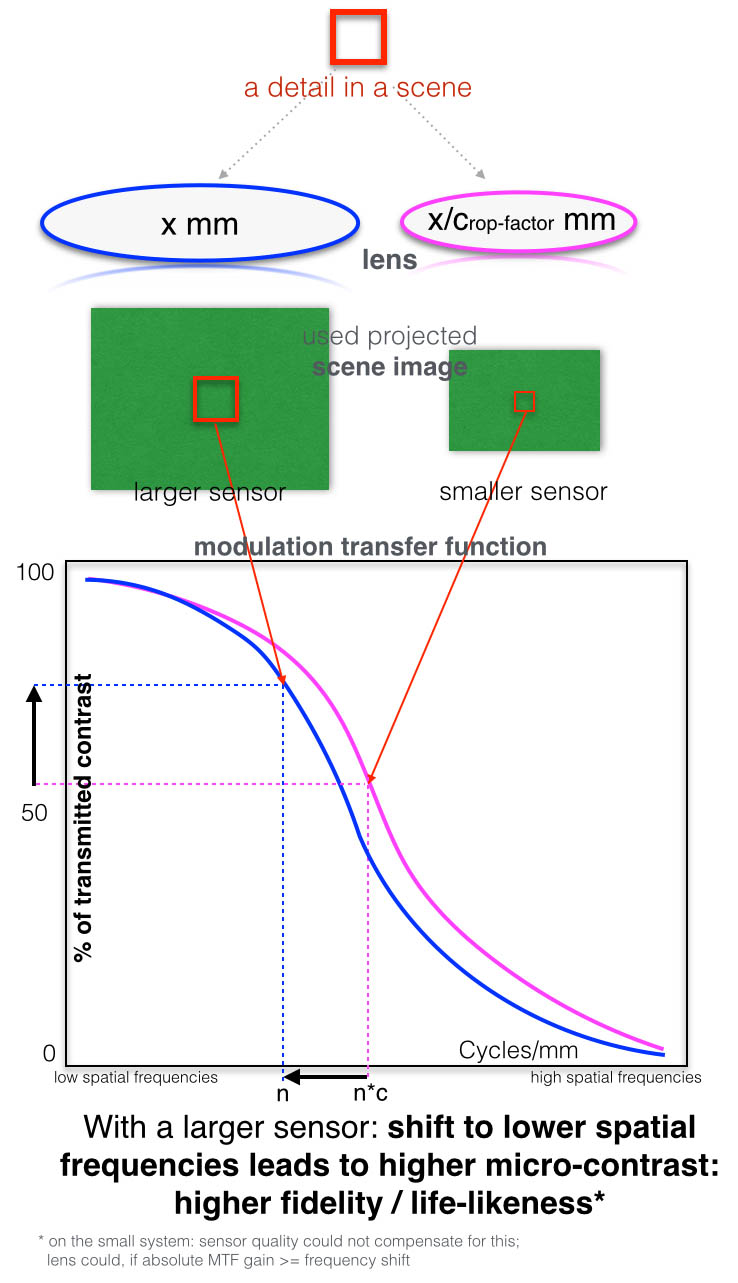Or how and why pictures from medium format and larger camera often look immersive
Answer: it's the lens spatial frequency advantage
It always struck me how medium and large format pictures looked more life-like to me. I've realized that it's not (just) a question of resolution and dynamic range nor shallow dof, as even "low" resolution jpeg pictures on the web could look vivid / "real".

Great 3D / life-like feel © Leszek Kowalski @ artlimited.net
Forget Film vs digital, forget CCD vs CMOS, forget anti-aliasing filter or not, forget megapixel race: what matters most - for image quality - is the sensor size... not because of the sensor performance but because of the lens!
SHIFT TO LOWER SPATIAL FREQUENCIES:
- Lens don't have infinite optical resolution: "transmitted" contrast decreases at high spatial frequencies (small details). c.f. Lens quality & Modulation Transfer Function
- For an identical image, if the format is larger, the same captured detail will be larger = you are using lower spatial frequencies that are easier to resolve (higher transmitted contrast) by the lens = better micro-contrast (the image that will be "sampled" by the sensor is better to begin with!).
It's a shift to lower spatial frequencies: The lens is used in a "better zone" of its MTF, meaning used in a better zone of its optical quality, giving a better micro contrast etc...
e.g. a 10um detail on a 24 x 36 mm sensor = a 18.3um detail on a 56 x 56 mm sensor. The lens will have to resolve a smaller detail on the 24 x 36 than on the 56 x 56 = the lense will have to be used at higher spatial frequencies - at lower contrast. 10um would correspond to 50 lp/mm versus 18.3um to 27 lp/mm. A lens transmitted contrast at 27lp/mm is better than at 50lp/mm (especially at wide apertures, see page 8 graph of Carl Zeiss' paper on reading MTFs
Summary: The larger the format, the lower the spatial frequencies beeing sampled, the better the micro transmitted contrast

An other simple way to look at it: A large format will "capture" more analogical optical details.
n.b. larger format "equivalent" lenses, as having to cover a larger image circle are more difficult to build and often have less good transmitted contrast at equal absolute spatial frequencies (that's why in my schema I shifted the blue - larger format lens MTF - to the left compared to the pink - smaller format), but as the used spatial frequencies are lower the end result is better overall transmission for the larger format (as long as the reduced transmission by absolute frequency performance is not bigger than the gain from using lower frequencies).
So maybe a 44x33 with a bad lens is not better than 24x36 with a good lens, but as long you're using good lenses and a larger enough format, the image being sampled is better to begin with, across all format relative spatial frequencies, not just at high resolution. Will this matter in the "final" image, that's another question (it depends on the image style... the amount of destruction by post-processing, print/screen quality & size, your taste)
Seeing (at Paris Photo 2011) a Richard Learoyd 8h exposure, giant direct-positive image, taken with his room sized camera obscura is an amazing experience c.f. Uncomfortably Close: Richard Learoyd's, Presences, that will not contradict this observation!
It's cost (and weight), not quality that keeps sensors small!
n.b. Obviously having a high number of megapixel is nice as lenses can produce (barely) visible/usable "details" up to MTF 5-2% transmission = at very high spatial frequencies. To sample those a high resolution is needed. High megapixel is good, but could not replace using the lens at its best ! As long as the sensor can sample at least the lens details at its MTF50 threshold, a 56x56 mm image will always be better than a 24x36 image, no matter the pixel count (as long as the lenses are good).
n.b. I'm wondering if semi / cropped - medium format digital camera with sensors as (too) small as 33 x 44 mm (Hasselblad H4D-40), 30 x 45 mm (Leica S2), up to (better) 49.1 x 36.8 mm (Hasselblad CFV-50), 56 x 36 mm (Leaf Aptus-II 10) 53.7 x 40.4 mm (Leaf Aptus-II 12) are worth the price! Compared to 24x36 they will, respectively, get a reduction - compared to 24x36 ff - in lens used spatial frequencies (= uncrop factor) of 1.27, 1.24, 1.42, 1.54, 1.55 (a detail corresponding to a spatial frequency of 50lp/mm would be reduced to, respectively 39.4, 40.3, 35.2, 32.47, 32.25 lp/mm)...
p.s. 'bought a Hasselblad CFV-50 digital back (with a KAF-50100 49.1 x 36.8mm - 2x FF surface! - 50Mpx CCD sensor from TrueSense=Kodak) Aug. 2012 ... (giving a 30% reduction in spatial frequencies for same view angle compared to 24x36 FF) to fit a 1980 used 500C/M, forming an acceptably cropped MF system. ;-)

Introduction to resolution and MTF curves
Do Sensors ?Outresolve? Lenses?
